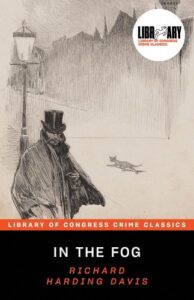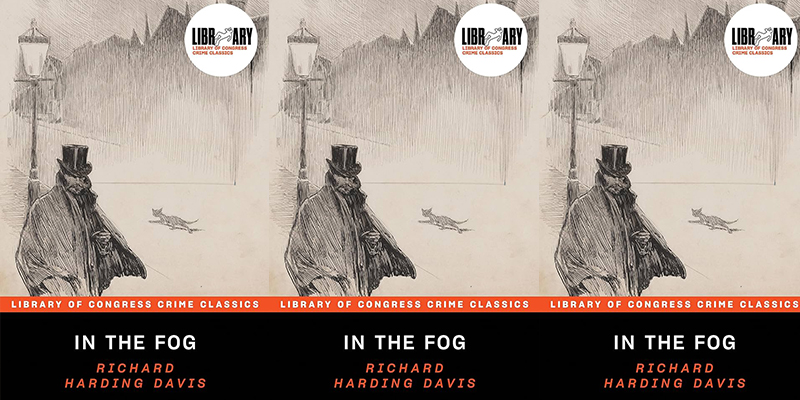At the turn of the twentieth century, American crime fiction was at a shallow ebb. Anna Katharine Green, who had achieved great success with The Leavenworth Case in 1887, continued to produce popular novels (and would do so until 1923), but the tastes of American readers of mystery fiction had turned to England. Certainly the popularity of the Sherlock Holmes stories had focused attention on British crime writing, but not until Mary Roberts Rinehart, whose first novel appeared in 1908, the popular The Circular Staircase, did American mystery writers again achieve success.
It is not surprising, then, that Richard Harding Davis— the most popular American journalist of the day—set a work of crime fiction in London. In his novella, a visitor to London becomes lost in the fog at night and wanders into a house, where he finds two murder victims. Three different narrators tell of the adventure and the resulting investigation. Though one reviewer hailed it as a “decided innovation in ‘detective’ fiction,” that was hardly the case; in fact, its charm is in evoking many of the clichés and popular settings of crime writing. Ellery Queen, the great mystery author/editor, hailed the tale as the “curtain raiser” of the first golden age of detective short-storytelling, “a perfect blend of Anglo-American storytelling.”
By the 1880s, fog had become a symbol of pervasive but hidden evil. Christine L. Croton, in London Fog: The Biography, observes:
A metaphorical relationship between social conflict and fog became apparent—a fear that the most brutal members of the residuum could spread across London, moving from east to west, like the fog, to upset the social balance and wreak havoc and destruction. In the West End disturbances of 1886, indeed, this threat for a time became a reality, further stoking the fires of social tension and anxiety.
The fogs of London had a special frisson for Victorian readers. Arthur Conan Doyle’s Holmes stories were indelibly set, with few exceptions, in fog- and smog-polluted London. Vincent Starrett, in his sonnet, “221B,” penned in 1942, characterized the setting of Doyle’s tales:
A yellow fog swirls past the window-pane As night descends upon this fabled street
A lonely hansom splashes through the rain, The ghostly gas lamps fail at twenty feet.
Of course, Doyle was not the only writer to immerse his tales in fog. Charles Dickens’s Bleak House (1853) describes “fog everywhere. Fog up the river…fog down the river, where it rolls defiled among the tiers of shipping and the waterside pollutions of a great (and dirty) city.” Robert Louis Stevenson’s Strange Case of Dr. Jekyll and Mr. Hyde (1886) has several scenes set in the fog, and the theme of pollution is central to the story: Jekyll’s downfall is brought about by “impurities” in the chemicals (as well as, of course, impurities in Jekyll himself). The London scenes of Bram Stoker’s Dracula (1897) are immersed in smoke, amid fears of the “unclean.” Indeed, even the fog itself could be a danger. In William Hay’s 1880 The Doom of the Great City, a black fog covers London for months, bringing death and destruction. Thus Davis’s evocation of a fog-shrouded city would have immediately set the stage for a tale of shocking crimes and characters who are not what they seem.
In the Fog was Davis’s first attempt at long-form crime fiction. His previous writing had achieved solid success but included only a few criminous stories. For example, his collections Gallegher, and Other Stories (1891), Van Bibber and Others (1892), and The Exiles, and Other Stories (1894) dabbled in the occasional tale of robbers or grifts. Throughout his career, Davis drew on his stints as a war correspondent in the Second Boer War (in South Africa) and the Spanish-American War, both reporting on the action and fictionalizing his experiences. (Winston Churchill and Jack London were also well-known war correspondents of the era whose other writing was informed by the stories they lived and heard.) Davis’s first great success, the novella The Princess Aline (1895), is about the adventures of a young American artist who falls in love with a picture of a European princess and travels to Europe to find her. The book was the fifth bestselling book in America in its year of publication.
Davis set out to make fun of the genre of crime fiction. The Englishman Sir Andrew, the lynchpin of In the Fog, is a devotee steeped in the mysteries of the French writer Émile Gaboriau and Arthur Conan Doyle (both specifically mentioned) as well as the countless other English and French crime writers of the day. The mystery reader was by nature an addict, Davis suggests, and certainly the bookstalls of fin-de-siècle London offered much to satisfy the addict’s cravings. The quantity of pre-twentieth-century crime fiction can only be estimated. Graham Greene and Dorothy Glover, for example, were assiduous collectors of those titles and in 1966 published a catalogue of their collection, consisting of 471 titles; however, Greene freely admitted that their collection was far from complete, and he hoped that in the ten years after publication, it would double in size.
Davis’s Arabian Nights–like novella of three linked tales focuses on intrigues of great popularity. The “lost explorer” and “unknown” places of Africa were still very much in the minds of English-speaking readers, who hungrily followed the reports of the journalist Henry Morton Stanley on his search of Dr. David Livingstone in the 1870s and Stanley’s continued explorations of Africa through the 1890s. Other explorers, such as John Hanning Speke and Sir Richard Francis Burton, also piqued the interest of armchair travelers around the world, and fiction such as the African novels of H. Rider Haggard and Joseph Conrad was widely read. (Though controversial today, Haggard’s and Conrad’s depictions of Africa and African people were extremely popular with White English and American readers of the day.) At the same time, the activities of Russian spies and the glamor of Russia’s extensive nobility were equally appealing. M.P. Shiel’s Prince Zaleski, published in 1895, was a well-regarded series of mysterious, somewhat supernatural tales of an exiled Russian prince, and works like Leo Tolstoy’s War and Peace and Anna Karenina were reaching widespread English-speaking audiences (both first translated into English in 1886).
Davis’s fiction often drew on his own life and experiences. For example, Davis admitted that The Princess Aline was drawn from his own infatuation with Princess Alix of Hesse-Darmstadt, who under the name Alexandra Feodorovna served as the Czarina of Russia. “Gallegher” was at least partially autobiographical: in 1916, the editor of The Bookman stated as fact that there was a real office boy employed by the Philadelphia Press named Tommy Gallegher. Davis was assigned by the Press to cover a fight in a stable in a suburb of Philadelphia, and when the police raided, arresting everyone, Davis slipped his report of the fight to Gallegher, who was able to make his way back to the newspaper offices with the story in time for the morning edition. However, the crime in “Gallegher,” as in the case of In the Fog, is fictional.
Davis himself had an adventure in the London fog in 1897, the same year in which he set this tale, and which was not unlike the events of the story. He had just finished Christmas dinner at the home of silent screen star Cecilia “Cissie” Loftus and her husband, Justin McCarthy, in the company of their mutual friend, the legendary actress Ethel Barrymore. Davis and Barrymore left the McCarthys’ around 11:00 p.m. Here is his own version:
There was a light fog. I said that all sorts of things ought to happen in a fog but that no one ever did have adventures nowadays. At that we rode straight into a bank of fog that makes those on the fishing banks look like Spring sunshine. You could not see the houses, nor the street, nor the horse, not even his tail.…The cabman discovered the fact that he was lost and turned around in circles and the horse slipped on the asphalt which was thick with frost, and then we backed into lamp-posts and curbs until Ethel got so scared she bit her under lip until it bled. You could not tell whether you were going into a house or over a precipice or into a sea. The horse finally backed up a flight of steps, and rubbed the cabby against a front door, and jabbed the wheels into an area railing and fell down. That, I thought, was our cue to get out, so we slipped into a well of yellow mist and felt around for each other until a square block of light suddenly opened in mid air and four terrified women appeared in the doorway of the house through which the cabman was endeavoring to butt himself. They begged us to come in, and we did—Being Christmas and because the McCarthys always call me “King” I had put on all my decorations and the tin star and I also wore my beautiful fur coat…I took this off because the room was very hot, forgetting about the decorations and remarked in the same time to Ethel that it would be folly to try and get to Barkston Gardens, and that we must go back to the “Duchess’s” for the night. At this Ethel answered calmly, “yes, Duke,” and I became conscious of the fact that the eyes of the four women were riveted on my fur coat and decorations. At the word “Duke” delivered by a very pretty girl in an evening frock and with nothing on her hair the four women disappeared and brought back the children, the servants, and the men, who were so overcome with awe and excitement and Christmas cheer that they all but got down on their knees in a circle. So, we fled out into the night followed by minute directions as to where “Your Grace” and “Your Ladyship” should turn. For years, no doubt, on a Christmas Day the story will be told in that house, wherever it may be in the millions of other houses of London, how a beautiful Countess and a wicked Duke were pitched into their front door out of a hansom cab, and after having partaken of their Christmas supper, disappeared again into a sea of fog.
Four years later, the imagination of Davis, still only thirty-seven, would spin a series of yarns that took shape from his own respite from the fog. Did Davis imagine himself as the dashing young American lieutenant? Was the Russian beauty another incarnation of his Princess Alix? These questions are intriguing but wholly irrelevant to enjoyment of this brisk tale. And so, into the fog…
______________________________


















